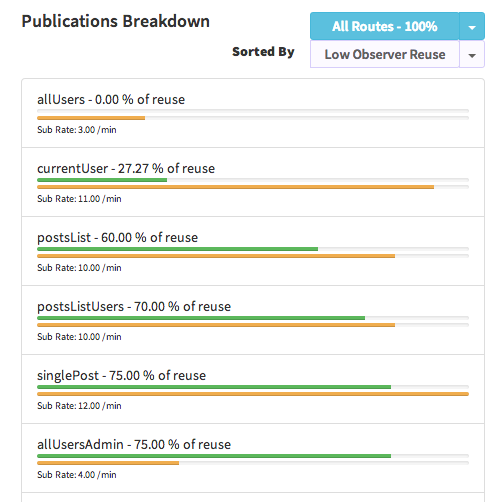Improve CPU and Network usage
Before we start, I’d like to explain a bit about some Meteor Internals that might help you to understand this topic better. To make it easier to understand, I won’t be using the exact terms Meteor uses internally.
How Observers are Handled in Meteor
When you are returning Mongo cursors from a publication, Meteor will create an observer for each cursor. These observers are responsible for sending document changes to the client in real time.
For example, the following code creates two observers for the Posts and Comments collections.
Meteor.publish('getPost', function(id) {
var cursors = [];
cursors.push(Posts.find(id));
cursors.push(Comments.find({post: id}));
return cursors;
});
When an observer is initializing, it will query mongodb for the initial dataset and send it to the client. After that, it will use oplog information to send data to the client (I assume your app is running with an active oplog).
But Meteor does something very smart: if you create multiple identical observers, Meteor won’t fetch the initial dataset from the DB for each observer. Instead, it reuses the data already fetched by the first observer. That’s what we are calling “an observer reuse”.
In order to create identical observers, you need to create cursors with:
- the same collection
- the same selector (query)
- the same set of options (including sort, limit, etc.)
How to Identify Whether Observers are Reusing or Not
Simply plug Meteor APM into your app. Play with your app for a while. Make sure there are multiple users using your app. Otherwise, the data won’t be realistic. In fact, if you can try this with a set of real users, you’ll be getting the most realistic values.
Now visit the Meteor APM Dashboard and switch into the PubSub Detailed View section. There you will find a metric called “Observer Reuse”, which tells you the percentage of Observer Reuse.

Additionally, you can sort publication by “Low Update Reuse” and identify which publications you need to improve.

If you are getting more than 75% of Observer Reuse, your publication is doing a great job.
How to Reuse Observer
I have shown you how to reuse observer by creating an identical cursor. In this section, I will use some realistic examples and show you how to improve their level of observer reuse.
Querying Data with a Time Limit
Take a look at the following cursor:
var dateBeforeOneDay = new Date(Date.now() - 1000 * 3600 * 24)
var messages = Messages.find({
time: {$gt: dateBeforeOneDay}
}, {
sort: {time: -1}
});
This cursor will have very low (near zero) Observer Reuse, simply because dateBeforeOneDay depends on the current time (in millis) when creating the observer.
Here is how you can fix this:
var now = Date.now();
var currentHour = now - (now % (1000 * 3600));
var dateBeforeOneDay = new Date(currentHour - 1000 * 3600 * 24)
var messages = Messages.find({
time: {$gt: dateBeforeOneDay}
}, {
sort: {time: -1}
});
The query above will normalize the currentTime into the currentHour. In this way, you can create identical queries while keeping your logic as it is.
Always Do a Null Check for _id
It is quite common to publish more user data into the client with a publication, as shown below.
Meteor.publish('currentUser', function() {
return Meteor.users.find({_id: this.userId}, {fields: {userType: 1}});
});
If you are getting a lot of public views for your app, most of the time this.userId will be null. Internally, if Meteor assigns a random id for each query, it comes with _id as null.
Because of that, each public page view will create a different observer. Those observers won’t expose anything or get anything from the DB, but they are unnecessary. A simple null check can be used to avoid this issue, as shown below.
Meteor.publish('currentUser', function() {
if(this.userId) {
return Meteor.users.find({_id: this.userId}, {fields: {userType: 1}});
} else {
this.ready();
}
});
Limit by User Given Values
Depending on some client logic, you can ask the server to limit the number of documents to be sent.
Meteor.publish('getRecentPosts', function(limit) {
return Posts.find({}, {limit: limit});
});
If you are sending a limit dynamically from the client and having a lot of possible values, this publication can’t reuse observers. Here is a fix for the example above.
Meteor.publish('getRecentPosts', function(limit) {
var base = 10;
var normalizedLimit = limit + (base - (limit % base))
return Posts.find({}, {limit: normalizedLimit});
});
Now you’ll be getting more than you requested to the client, but it will give you a better Observer Reuse percentage. Play with the base value to get the optimal result.
Observer Reuse is one of the key metrics you can use to improve the CPU and network usage of your app. So be sure to stay alert to the Observer Reuse of your Meteor app.
